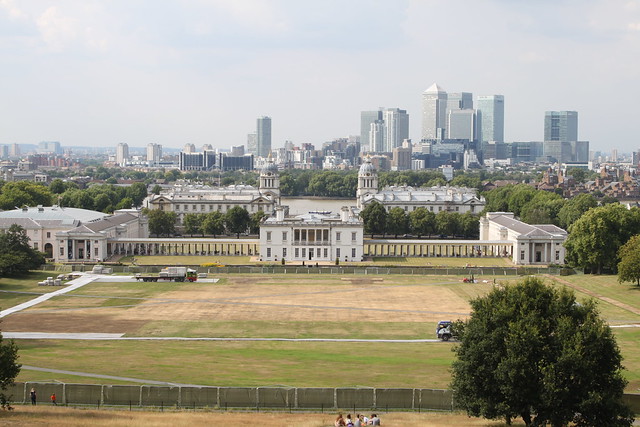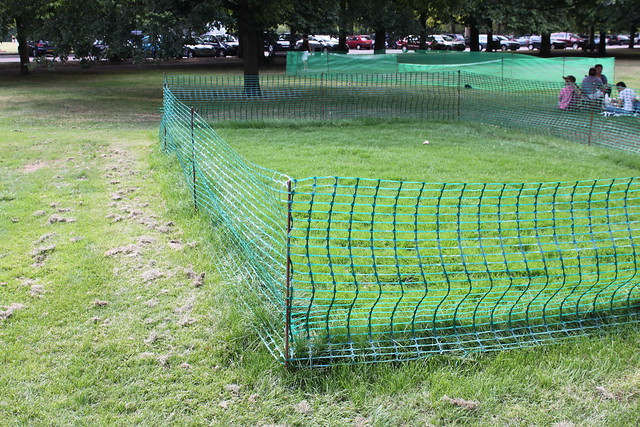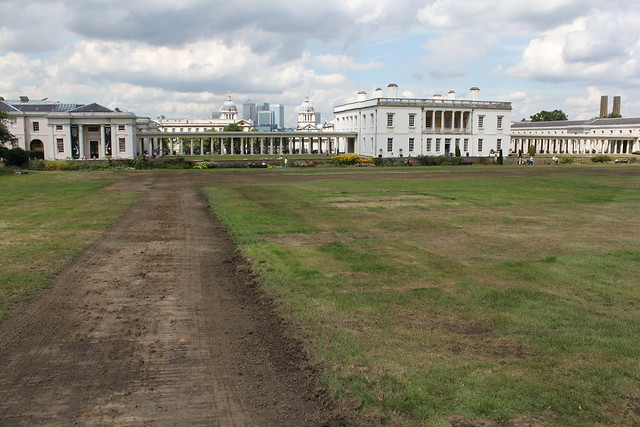The reinstatement of Greenwich Park is now under way following last month’s test events for London 2012.
The local media were invited to a briefing and tour last week with officials from London 2012 and Royal Parks.
“We planned it to go well and it is going well. I’m really pleased at the moment,” said Derrick Spurr, Royal Parks’ Project Manager for 2012. “Depending on getting the right weather conditions, I reckon by mid to late September you won’t even know the event has taken place.”
What are the right weather conditions?
“Growing season for us starts to end for grass seed towards the end of October because you’ve got soil temperatures and you’ve got moisture, hopefully, in the autumn.
“After that time, when the soil temperature drops, grass seed won’t germinate so you’re then into turfing which we don’t particularly want to do because you’re introducing different grasses.
“By using seed, we can select the grass that we want so it matches the rest of the field. The ideal growing conditions are warmth and moisture. If you’ve got those, grass will germinate in ten days to a fortnight.”
The first areas to be treated are on the bandstand field where service buildings were placed for the Cross Country. The temporary green fences should be coming down over the next week, says Spurr.
“As we’re given an area back, we’ve immediate gone in and started doing the repairs. De-compacting the ground, getting some air in to the ground, cultivating and putting down grass seeds”
“If you went all over the cross country course, you would have great difficulty in finding evidence of sporting activity,” he says.
The most visible evidence of activity is not on the cross country course but down in the flat area, south of the Queen’s House, where a track way was placed around the arena.
Michael Loughnane, Assistant Park Manager for Greenwich Park, said in a statement on Friday, “On 3 and 4 August the track way was removed from the park and following this there was a heavy downpour of rain. We have now aerated the ground that was previously covered by the track way to allow the air in and to increase the draining capacity.
Today [Friday] and on Monday we will prepare the remaining areas of the surface for seeding which will take place early next week. These areas will be protected with temporary green mesh fences to allow the grass to grow. The park will be fully reinstated and we expect the ground to recover within four to six weeks.”
Back at the briefing, the track way is identified by Tim Hadaway, London 2012 Equestrian Competition Manager, as an area where lessons can be learned for next year.
“Because of the short time frames in terms of the venue only being finished just before, a lot of that track way stayed down during the event and it’s fine for vehicles but not the greatest surface when you’ve just got pedestrians, and in the back of house areas where you’ve got the horses, so we actually had to start put coverings over it for the sake of the horses.
“We’ll look much more closely at what of that stays down and what of it comes up during the event. You need to put it down during the build stage to protect the ground but then during the event in certain areas it can come up.”
London 2012 Venue General Manager, Jeremy Edwards, says the test event has been “successful.”
“What we’re doing at present back in the office is looking at lessons learned from here and moving on to 2012 with our planning and just refining a few our techniques”
“It was a test event so certain things needed to be tested. Some you’ll get right and some you may not get right.”
He says there are lots of “bits and pieces” that they will be looking at – for example, there are “different thoughts” around how deconstruction will take place.
One aspect of the test event that did in come for criticism after the showjumping stage of the event was the surface in the area itself with one rider saying it felt like a “pudding”
“There’s going to be some more testing done on the surface throughout the year at other horse shows. There’s also a bit of scientific work that goes on.” says Edwards.
British rider William Fox Pitt said after the event that the descent from one of the jumps was “punishing” for the horse. Would the course designer be taking that on board?
“You need to strike the right balance around any course between using the terrain to create the technical test but still ensuring it’s appropriate for the horses, ” says Hadaway. “I think it was just a comment that that was one of the more taxing parts of the course from the horse’s perspective but no more or less so than you would have other difficult elements in courses around the world.”
“Any of those comments are always seen in a positive light, ” says Jeremy Edwards. “It’s always good for us – whether you’re the course designer or running the catering programme – it’s always good to get constructive feedback.”



